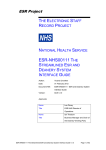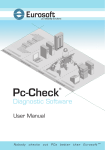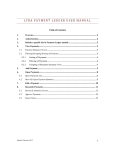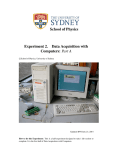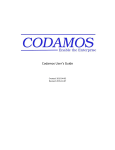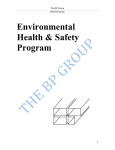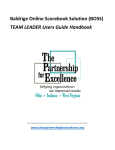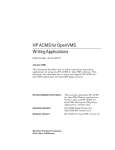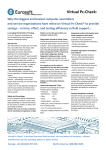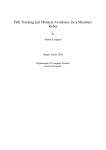Download ESR-NHS0200 OLM Implementation Guide
Transcript
THE ELECTRONIC STAFF RECORD PROGRAMME NATIONAL HEALTH SERVICE ESR-NHS0200 OLM IMPLEMENTATION GUIDE Information Classification: Commercial in Confidence Owner: Nick Adcock Author: Matthew Lye Creation Date: October 2012 Last Updated: September 2014 Version: 4.0 Approvals: Name Nick Adcock Title Senior Development Advisor Name Title ESR-NHS0200 OLM Implementation Guide 1. DOCUMENT CONTROL 1.1. CHANGE RECORD Date Author 17/10/2012 18/12/2012 29/07/2013 16/09/2013 28/11/2013 18/09/2014 20/10/2014 James Haddon Nick Adcock Matthew Lye Nick Adcock Nick Adcock Matthew Lye Nick Adcock Version 0.1 1.0 1.1 2.0 3.0 3.1 4.0 Change Reference Initial draft Reviewed for version 1 General review and update Reviewed for Version 2 Updated Document References General review and update Review completed for uplift to Version 4 1.2. REVIEWERS Name Position Nick Adcock Judith Chapman James Haddon Chris Moorley Jo Sidebottom ESR Senior Development Adviser ESR Senior Account Manager ESR Development Adviser ESR Development Adviser ESR Senior Account Manager 1.3. DISTRIBUTION Copy No. Name Location 1 2 Library Master Project Library ESR-NHS0200 OLM Implementation Guide Page 2 of 26 2. CONTENTS 1. DOCUMENT CONTROL ...................................................................................................................................... 2 1.1. 1.2. 1.3. CHANGE RECORD ........................................................................................................................................ 2 REVIEWERS .................................................................................................................................................. 2 DISTRIBUTION............................................................................................................................................... 2 2. CONTENTS............................................................................................................................................................ 3 3. INTRODUCTION TO ESR LEARNING MANAGEMENT ............................................................................... 5 3.1. BENEFITS ..................................................................................................................................................... 5 3.2. W HAT DOES IT LOOK LIKE? .......................................................................................................................... 5 3.2.1. Stage 1: Setup and Maintenance ........................................................................................................ 6 3.2.2. Stage 2: Enrolment ................................................................................................................................ 7 3.2.3. Stage 3: Approval .................................................................................................................................. 8 3.2.4. Stage 4: Outcomes ................................................................................................................................ 8 3.3. INTEGRATION.............................................................................................................................................. 10 4. PREPARING FOR A SUCCESSFUL IMPLEMENTATION.......................................................................... 11 4.1. 4.2. 4.3. 5. IMPLEMENTATION PLAN ................................................................................................................................ 12 5.1. 6. W HAT SHOULD THE IMPLEMENTED SOLUTION LOOK LIKE? ....................................................................... 12 REVIEW OF BUSINESS PROCESSES .......................................................................................................... 13 6.1. 6.2. 7. SETTING UP THE PROJECT ......................................................................................................................... 11 PROJECT INITIATION DOCUMENT ............................................................................................................... 11 ESR GUIDE TO PROJECT MANAGEMENT .................................................................................................. 11 COMMUNICATION ....................................................................................................................................... 13 OUTDATED PROCESSES ............................................................................................................................ 13 IMPLEMENTATION ............................................................................................................................................ 14 7.1. 7.1.1. 7.1.2. 7.2. 7.3. 7.4. 7.5. 7.5.1. 7.6. 7.6.1. 7.6.2. 7.6.3. USER ACCESS ............................................................................................................................................ 14 E-Mail Addresses ................................................................................................................................ 15 NHS CRS Smartcard Requirement .................................................................................................. 15 MIGRATION ................................................................................................................................................. 15 TRAINING AND SUPPORT............................................................................................................................ 16 CATALOGUE CREATION.............................................................................................................................. 17 CERTIFICATIONS ........................................................................................................................................ 18 Considerations ..................................................................................................................................... 18 E-LEARNING ............................................................................................................................................... 19 I.T. Support ........................................................................................................................................... 19 Local Content ....................................................................................................................................... 19 Communication .................................................................................................................................... 20 8. REPORTING ........................................................................................................................................................ 20 9. APPENDIX A – OVERVIEW OF KEY OLM FUNCTIONALITY .................................................................. 21 9.1. 9.2. 9.3. 9.4. 9.5. 9.6. 9.7. 9.8. 9.9. 9.10. 9.11. 9.12. 9.13. 9.14. 9.15. 9.16. COMPETENCIES / COMPETENCY REQUIREMENTS ..................................................................................... 21 LEARNING CERTIFICATION ......................................................................................................................... 21 LEARNER GROUPS ..................................................................................................................................... 21 EVALUATIONS ............................................................................................................................................. 21 ENROLMENT ............................................................................................................................................... 22 LEARNER ACCESS RESTRICTIONS............................................................................................................. 22 OLM EMAILS .............................................................................................................................................. 22 STANDARD LETTERS .................................................................................................................................. 22 OLM AND SELF SERVICE........................................................................................................................... 23 SHARED TRAINING CENTRES..................................................................................................................... 23 LEARNING INSTRUCTOR URP .................................................................................................................... 23 ELEARNING ACCESS .................................................................................................................................. 24 NATIONAL ELEARNING CONTENT AND RESTRICTIONS .............................................................................. 24 LOCAL ELEARNING CONTENT .................................................................................................................... 24 LEARNING ADMINISTRATION URP AND ELEARNING .................................................................................. 24 PLAYING AND ENROLLING ON ELEARNING................................................................................................. 24 ESR-NHS0200 OLM Implementation Guide Page 3 of 26 9.17. 9.18. 9.19. 9.20. 9.21. 9.22. 9.23. 9.24. 10. ELEARNING USER URP ............................................................................................................................. EMPLOYEE SELF SERVICE URP................................................................................................................ ENABLING REMOTE (INTERNET) ACCESS .................................................................................................. TESTS AND QUESTION BANKS ................................................................................................................... RESOURCES ............................................................................................................................................... CUSTOMERS............................................................................................................................................... SUPPLIERS ................................................................................................................................................. ANNOUNCEMENTS ...................................................................................................................................... 25 25 25 25 26 26 26 26 APPENDIX B – REFERENCES .................................................................................................................... 26 ESR-NHS0200 OLM Implementation Guide Page 4 of 26 3. INTRODUCTION TO ESR LEARNING MANAGEMENT The Oracle Learning Management component of the Electronic Staff Record (ESR) enables comprehensive control over all the activities associated with the learning and development of NHS staff. This includes the administration of courses, both face to face and e-learning, and the recording of learning taken by every employee. Courses can be linked to defined competencies, including national competence frameworks, so that current employee competencies and progress towards those competencies can be updated and monitored. The use of national mandatory competencies can lead to a reduction in staff undertaking unnecessary duplicate learning when transferred using the Inter Authority Transfer (IAT) process). 3.1. BENEFITS Enables NHS organisations to manage all aspects of the delivery and maintenance of a learning service OLM supports a blended approach to Learning with organisations able to offer, in one place, eLearning and classroom based learning. Free nationally approved, quality assured and centrally maintained e-learning content Access locally procured or created e-learning through ESR Certifications enable staff to view the status of their compliance based learning and see if and when it needs to be renewed Automatic notifications to remind staff and managers when learning needs to be renewed. Evaluations to record learner’s views of learning undertaken to support continuous improvement. Learning paths provide personalised and targeted learning for groups of staff or individuals, created centrally, using self service or as part of the appraisal process. Associate competencies with a certification, course or learning path and automatically update Employee records on successful completion of learning. National competence frameworks including the Knowledge and Skills Framework (KSF), National Occupational Standards (NOS), National Workforce Competencies (NWC), Core Skills Training Framework (CSTF) and an agreed set of Mandatory Competence labels (MAND) to support monitoring of compliance levels against statutory and mandatory training Reduction in staff undertaking unnecessary duplicate learning when transferred using the Inter Authority Transfer (IAT) process. Local competences can be created, or additional national ones requested. Reports enable learning and development to be monitored at all levels of a Trust hierarchy Automatic customisable e-mails delivered to staff at key stages in a learning event Creation of tests to assess learner understanding, providing valuable feedback on whether business goals and workforce objectives are being served For a more comprehensive list of features, please see Appendix A. 3.2. WHAT DOES IT LOOK LIKE? The ESR Learning Management process contains four stages: Example screens for each of these stages are shown below: ESR-NHS0200 OLM Implementation Guide Page 5 of 26 3.2.1. Stage 1: Setup and Maintenance Figure 1 - Learning Administration Form With this form, a Learning Administrator can access all information relating to a course catalogue. New certifications, courses, classes and learning paths can be set up and existing ones maintained. ESR-NHS0200 OLM Implementation Guide Page 6 of 26 3.2.2. Stage 2: Enrolment This form is used by the Learning Administrator to enter student details against classes. Figure 2 - Single Enrolment Form Learning Administrators can view all the employees on the system. Information on where each employee works and their internal/external address is available and can be used to generate letters. When the employee email address is recorded against their HR record this is also pulled through to the enrolment form enabling the automatic generation of a customisable enrolment email to the employee. The email contains information on the date, time and location of the class. Figure 3 - Self Service Enrolment Form Employees can search for and enrol on learning opportunities, with no need for centralised or manager approval. Alternatively learning can be setup to send a notification to the requesting employee’s supervisor for them to approve. See the Self-Service factsheet available from the ESR Website for more details ESR-NHS0200 OLM Implementation Guide Page 7 of 26 3.2.3. Stage 3: Approval Figure 4 - Manager Approval of Enrolment from Self Service Managers can choose to approve or reject the enrolment, or alternatively courses may be setup so that no approvals are required at all The Manager retains the final approval on learning but has the ability to route the request to other senior staff if necessary. This enables increased control over learning budgets, and minimises administrative overheads. 3.2.4. Stage 4: Outcomes Figure 5 - Update of Enrolment Status The Learning Administrator can update the student status for an entire class in one operation. It is also possible to highlight those staff that did not attend, and record a reason for future analysis . ESR-NHS0200 OLM Implementation Guide Page 8 of 26 Figure 6 - Learner Homepage Managers and employees are able to see which competences are due for renewal and search for a Certification, Course or Learning Path that will award them with this competence on successful completion. Figure 7 - Individual Compliance Matrix Managers and employees are able to view the status of compliance against themselves and their employees in a simple intuitive form using a standard Red Amber Green status. Managers and administrators can also view this information via ESR Business Intelligence. ESR-NHS0200 OLM Implementation Guide Page 9 of 26 Figure 8 - NHS Compliance Dashboard 3.3. INTEGRATION Learning Management is fully integrated into the Electronic Staff Record meaning learning functionality can be leveraged in other areas of the system as visualised below. Learning Management Talent Management ESR-NHS0200 OLM Implementation Guide Self Service Page 10 of 26 4. PREPARING FOR A SUCCESSFUL IMPLEMENTATION This document is targeted at anyone wishing to implement OLM functionality. Although it is recognised that organisations will vary in size and complexity, the underlying principles of any project should remain the same. Before embarking upon an OLM implementation there are a number of activities to be performed in order to ensure that the project is a success and meets the business requirements. 4.1. SETTING UP THE PROJECT Learning and Development is managed in different ways in different organisations, and OLM can be set up in such a way as to meet the organisational requirements – and also provides a good opportunity to review ways of working to see if efficiency gains can be implemented at the same time. It is important that this is seen as a project in its own right which will need to be carefully controlled and managed in order to be effective. All successful implementations will have robust project governance, a project manager / lead, project planning, project control documentation and formal communication procedures. All staff involved in OLM implementation should register for kBase, ESR’s Knowledge Management System, at https://www.electronicstaffrecord.nhs.uk/kbase/register/ 4.2. PROJECT INITIATION DOCUMENT All projects, regardless of size, should establish a vision for the wider use of ESR within the organisation. This is known as a Project Initiation Document (PID) in which you define the project’s scope and direction and use it as the basis for its authorisation, management and assessing success. The document details all the foreseeable areas of the project, such as goals, scope, risks, controls and budget. It is appropriate to review, revise and publish this vision before embarking on the project. Adopting this approach will provide a guideline and framework for all involved in the project, and assist with gaining the necessary backing and buy-in from the various stakeholders. 4.3. ESR GUIDE TO PROJECT MANAGEMENT The NHS Central Team have developed a generic guide to project management to support organisations implementing ESR functionality. A copy of this guide is available via Kbase. ESR-NHS0200 OLM Implementation Guide Page 11 of 26 5. IMPLEMENTATION PLAN 5.1. WHAT SHOULD THE IMPLEMENTED SOLUTION LOOK LIKE? In order to define clearly the scope of the implementation project, certain decisions will need to be made in advance to ensure the approach is in line with the organisation’s Learning and Development Strategy. These include: 1. Scope of learning to be recorded: a. Will all learning provided by the organisation be managed in ESR? If not what is the need for collated reporting and how will this be achieved? b. Delivery modes – what type of learning will be recorded / completed in ESR? For example do you plan to use e-Learning and/or classroom based training, mentoring etc? c. If e-Learning is to be used, does the organisation have any of its own content to be accessed via ESR, or is only national content to be used? 2. Self Service: Does the organisation already use self-service? If so consideration will need to be given as to how learning should be made available for enrolment. More details on this can be found in the online ESR User Manual. 3. Access: Will learning be recorded by a specific central department, or will access to learning be devolved out to other areas of the organisation to manage? Organisations will want to consider whether to distribute the Learning Administration URP or the Learning Instructor URP which gives the ability for those identified as Internal Trainers in OLM to View/Update Enrolments View Class Details View the booked resources View any prerequisites View their booking history 4. Shared Training: If the organisation has a reciprocal training agreement with another NHS organisation whereby training is offered to the other organisation (and in particular if both organisations are using Self Service and wish employees to enrol directly) then it is possible to set up shared training centres in ESR to enable training to be seen and booked across organisations. There are more detailed set up requirements for this functionality, such as the role of the ‘STC Learning Administrator’, the ability to select which classes are to be shared with customers, and enhanced notification options. If using Shared Training Centre functionality, organisations should thoroughly examine and agree the procedure to ensure the correct working arrangements are in place between the Provider and each Customer organisation. Organisations wishing to set up STC need to raise an SR to begin the process. 5. Compliance: How will compliance be managed? Most organisations will use competencies to report compliance at both a central and manager-employee level (utilising functionality such as the competence requirements search on the Learner Homepage, compliance matrix and ESR Business Intelligence shown in the ‘What does it look like?’ section). Consideration will need to be given as to which courses meet a competency need and the setting of competency requirements against staff position information. More detail on how to use competencies and competency requirements is available in the online ESR User Manual. In addition organisations will need to consider the use of Certifications to manage renewable e-Learning courses. This functionality enables the learner to see all the courses that require renewing in one place on their Learner Home page. Learning Administrators will need to review the training offered and create Learning Certificates for each course as appropriate, determining the renewal period, when they would like to allow learners to being the renewal process and associate any competencies with the Certification. More details can be found in the ESR User Manual. Learning Certification is covered in more detail in the Certification section of this document ESR-NHS0200 OLM Implementation Guide Page 12 of 26 6. REVIEW OF BUSINESS PROCESSES 6.1. COMMUNICATION When implementing any system it is best practice to review the processes that go along with that system. As ESR is an integrated workforce information solution, steps should be taken to ensure there are clear and efficient communication channels between HR, Payroll, I.T. and Learning; these areas will be key to ensuring the smooth running of the project. 6.2. OUTDATED PROCESSES There may be ways of working that need to be changed regardless of the introduction of the new functionality. These might include unproductive relationships between key central functions, outdated cultures or previously unchallenged working practices. Process reviews should be one of the first considerations of the project, and aligned with ESR functionality to maximise the benefits derived. Map out your existing processes, making use of any existing procedure notes. You should include: Who is the owner of each process Which systems are used and how (include both electronic and manual elements) How is data transferred from one area to another (for example how is data entered / transferred) Strengths/weaknesses in the current ways of working Map all of the processes including those which cross both internal department and external organisational boundaries, to the organisations that are providers or recipients of training services. Ensure you clearly understand and document existing processes so that these reflect accurately what actually happens. Document the changes that need to be made to enable effective practice. A decision can then be made as to whether processes can change immediately or as part of the wider implementation. The review should also include ways in which the organisation can utilise ESR effectively as part of any new ways of working and agreements put in place as to how users are to operate with the system following implementation. ESR-NHS0200 OLM Implementation Guide Page 13 of 26 7. IMPLEMENTATION The precise detail of your implementation will depend on your vision for Learning Management in the light of earlier sections of this guide. However in every case you will either need to, or give consideration to, the following: 7.1. USER ACCESS The organisation’s ESR System Administrator will need to grant the relevant access to anyone intending to use the system. This may include: Learning Administrators Trainers (Instructors) Support Staff (Password resets etc) End Users A number of access responsibilities are available that may be given to different areas. You should familiarise yourself with what each of these responsibilities has access to (testing in the TPLY test environment is normally a good starting point. Your account manager will be able to help you access this). Responsibilities include: Learning Administration – Enables the creation of the course catalogue and general administration of learning. Career Management – Setup and maintenance of competencies and requirements. Learning Instructor – Enables trainers to view and update enrolments on classes they are responsible for. Local Password Reset – Enables support staff to reset user account passwords. e-Learning User – Allows users to enrol on learning (classroom based and e-learning) and play both local and national e-Learning content. ESR BI Admin – Enables the modification of existing dashboards and analysis and the creation of new ones. Devolved training departments will require the same level of access, although as mentioned in previous sections these could be granted the more limited Learning Instructor URP instead. During implementation you may need to setup a large number of users to access the system. This can be completed manually, or central support may be available to help you. To determine whether support is available centrally, a service request should be raised by your ESR System Administrator. Examples of the support available, include the bulk creation of usernames, competency requirements and competencies. You will also need to consider how new employees get access to the system. This process can be automated by using the ‘Automatic User Account Creation’ process. Simply select one of the Auto User Account Creation options so that all new hires are automatically given a user account and your choice of URPs when they start with the organisation. This is created once an applicant has their status changed to Offer Accepted the options available for selection are: ESR-NHS0200 OLM Implementation Guide Page 14 of 26 Figure 9 - Auto User Creation Where No Approval Required for Remote Access is indicated this means that any learners who request Remote (Internet) Access will have it granted automatically without approval being required from a manager or Learning and Development Administrator. Please note that even if you are using Employee Self Service, every learner will need the eLearning User URP in order to play eLearning. More details on how to use this can be found in the ESR User Manual here. 7.1.1. E-Mail Addresses To enable organisations to realise the full benefits of learning management in ESR, it is essential that email addresses are populated against each employee. This enables functions such as: Automated administration emails – emails on joining, class cancellation etc. See section 8.1.1 for more details. Login Assistance - This can also be used for retrieving initial User name and Password if the email address held on ESR is known by the learner. E-mail addresses can either be populated manually on the employee’s person record, or a central massupdate may be available to support you. To support the on-going maintenance of this the NHS Interface Team have developed an Active Directory interface to populate the e-mail address in ESR from your local Active Directory setup. To determine whether support is available centrally, a service request should be raised by your ESR System Administrator. 7.1.2. NHS CRS Smartcard Requirement For NHS Organisations in England a smartcard may be required to access the system. Users with only Supervisor Self Service (Limited Access), Employee Self Service, Employee Self Service (Limited Access) Learning User and e-learning User URPs do not require a smartcard although you may choose to enforce this if desired. Any additional URP added to the account will necessitate the issuing of a smartcard. 7.2. MIGRATION You will need to consider whether to migrate any existing or historic learning records from other systems or records. Your decision is likely to depend on the quality and accuracy of any existing data, as well as the ease of gathering it. Support to migrate your data to ESR is available and, if you are migrating to using ESR Learning Management from another system, there is unlikely to be any costs involved. It is highly recommended that competencies are migrated to OLM to fully utilise the features in ESR such as the Compliance Matrix and Business Intelligence reports. ESR-NHS0200 OLM Implementation Guide Page 15 of 26 To determine whether support is available centrally a service request should be raised by your ESR System Administrator. If a central load is not available or feasible you may decide on an alternative approach: To archive historic data for reference only and create new learning records for staff in ESR. To input existing and historic records manually (this may support the training of new learning management users) 7.3. TRAINING AND SUPPORT You should ensure that those responsible for implementation and end users receive the necessary training on the relevant ESR functionality. Knowledge gaps should be determined first, and an assessment then made as to which of the following training delivery mechanisms are most appropriate. It is also recommended that a Learning Administrator has access to Remedy and McKesson Information Point (MIP). Both of these are managed by McKesson for users to raise and view any problems or system issues with ESR. Formal training courses on OLM and other aspects of ESR functionality are available free of charge to NHS Organisations as part of the ESR contract. The course dates are communicated via the ESR Education Schedules distributed to NHS Organisations in User Notices. Further information on available on available training can be found on McKesson Information Point or upon request from [email protected] Virtual training courses are available from McKesson. If you do not already have access to these materials, log a Service Request (SR) detailing the name, organisation, courses required, contact number and email for each individual involved, so that Training Accounts can be set up. A number of OLM Captivate Online Learning packages are available on ESR and Kbase. Use the TPLY (Test and Play) ESR Environment (Raise an SR if you do not have access to this). The ESR User Manual is available from the references section in the appendices of this document. The NHS ESR Account Management Team are available to provide advice and guidance wherever possible during the decision making process and before, during and after the implementation. Support can include: Briefing and decision making sessions Attendance at local Special Interest Groups, workshops etc. Project planning session with the designated Project Manager Data migration advice Post implementation review. For a list of account managers please see the ESR Website. ESR-NHS0200 OLM Implementation Guide Page 16 of 26 7.4. CATALOGUE CREATION The catalogue is comprised of a number of objects – the ones you’ll need to be familiar with in the first instance are Certifications, Courses, Offerings and Classes. Certifications are covered in the next section. The other objects are linked and represent the following information: Object Name Course Offering Class Meaning Subject of the Learning Delivery Mode Instance of the Learning Example 123 Fire Safety 123 Fire Safety (Classroom) 123 Fire Safety 01-Mar-2013 The objects are therefore linked as below: Class Offering Class Course Offering Class When defining the course catalogue it is important to remember some key points: 1. All courses should be prefixed with the Trust Identifier (VPD). This will allow for distinctions when reporting if for example you are part of a shared training facility, merge/demerge and for users to easily distinguish between nationally created courses and those of the organisation. 2. In setting up a course it is important to consider the learner and ensure that any course names are meaningful, descriptions are given on the course metadata and the learner will recognise the relevance of the course. There is a limit of 80 characters for course, offering and class titles. 3. Any e-Learning which is delivered by the organisation will require testing to ensure it is compatible with the industry standards used by ESR. There should be no issues with SCORM 1.2 or 2004 compatible content, but some bespoke solutions will require testing. 4. The ESR learning management system does not host e-Learning content, but instead links to it via a URL. This approach offers increased flexibility to include e-Learning and knowledge resources from a wide range of different sources in the same catalogue. Hosting arrangements will therefore need to be in place to make sure e-Learning content is available, i.e. it will need to be placed on a web server. (National content is maintained centrally and is automatically available to all organisations). 5. Where the organisation is using local e-Learning content then you will need to download the latest SCORM adapter, and follow the simple instructions for placing this on the same server as the content. In order for the user base to access content remotely it will need to be placed on an internet facing web server (e.g. a www. domain as opposed to nww). ESR-NHS0200 OLM Implementation Guide Page 17 of 26 7.5. CERTIFICATIONS This section outlines considerations for Learning Administrators when implementing Certifications and also details the changes to national e-Learning content; including how competency labels associated with the course will be dealt with. 7.5.1. Considerations Subscribing and Enrolling Learners: The options are: 1. Leave learners to subscribe and enrol themselves using the Competence search on the Learner Homepage 2. Subscribe learners as competency needs renewing 3. Subscribe all learners to appropriate certification and optionally enrol them on the class Option 1 is the recommended approach as this will ensure that Competence expiry dates and Certification due dates displayed to the Learner are consistent with each other. Option 2 will also ensure consistency between Competence expiry dates and Certification due dates and can be used if a Certification has not been set up for Self Enrolment. Course Changes: 1. National courses are not refreshed on an annual basis, if organisations require learners to complete national courses on a regular basis then they must be set up as Components of Certifications. This logic would also apply to locally created e-Learning content. 2. Where there are future changes to national content, every effort will be made to retain the existing course title, and where possible a new offering and class will be defined instead. This will mean that no new Certifications would need to be created or existing ones changed. Competencies: 1. Local Certifications will need to be created with the appropriate national and/or local competencies attached. 2. Administrators need to ensure that the appropriate national competency, with a renewal period matching the Certificate renewal period is chosen. Reporting: 1. Discoverer reports are updated to mark if the user enrolment is part of a Certification 2. Competencies will continue to be used for compliance reporting 3. The ‘Export’ button is available to report on all learners subscribed to a specific Certification. 4. A Standard report OLM Certification Report will provide users with a list of delegates that have subscribed to a learning certification and their status. Common Scenarios: the subscription status does not update 1. A process will run overnight that will synchronise Certification and Class status 2. Subsequent issues would require the Certification status to be updated an individual needs to undertake training again following disciplinary action. ESR-NHS0200 OLM Implementation Guide Page 18 of 26 1. The individuals’ record would need to have the ‘Due Date’ and ‘Status’ updated manually by the Learning Administrator. Further information on Certifications can be found in the Certification FAQs on KBase. 7.6. E-LEARNING The implementation of e-Learning in ESR should be treated in the same way as any other essential I.T. system implementation would be treated. To ensure the successful deployment of this functionality, it is essential that the I.T. department are involved at an early stage to ensure the required software and / or hardware is in place, and has been fully tested. Although senior management backing should be sought for any implementation, it is especially important here to ensure the correct messages are made known during roll out. 7.6.1. I.T. Support The quickest way to view the requirements of e-Learning in ESR is to use the I.T. checklist available below (click the image to follow the link): Figure 10 - I.T. Checklist Full details of I.T. configuration with associated lessons learned / resolutions can be found in the M-0100 document available in the references page of this document. 7.6.2. Local Content If your organisation wishes to add content created or procured locally to ESR, you must follow some simple steps outline in the quick start document below (click the image to follow the link): Figure 11 - Quick Local Content Setup Full details around the specifications for local e-Learning content can be found in the ESR-NHS0167 NLMS Content Guidance and Standards document available in the references page of this document. ESR-NHS0200 OLM Implementation Guide Page 19 of 26 7.6.3. Communication It is important that the correct methods of communication are established – especially with e-Learning – to get the message out to all users to ensure they use ESR instead of any pre-existing systems. More information on how this can be achieved can be found in the ESR Communications Toolkit available in the references page of this document. 8. REPORTING A large suite of dashboards, analyses and standard reports are available across all of the functionality in ESR. The links provided below will help give you more information on what each report is designed to do and the fields it contains. Users with the ESR BI Admin URP or Discoverer Ad Hoc URP or are able to customise or even create their own dashboards and reports from scratch. Link Reports User Manual ESR Business Intelligence Reports ESR-NHS0200 OLM Implementation Guide Description The reports user manual lists all standard reports available in ESR and the fields contained in each. Provides documents developed by the NHS Development Team to support users in the utilisation of ESR Business Intelligence reporting. Page 20 of 26 9. APPENDIX A – OVERVIEW OF KEY OLM FUNCTIONALITY In order to define a realistic vision for the effective use of OLM, it is important to have a basic understanding of the functionality available within it. More information about OLM functionality is available in the ESR User Manual which, with other useful support information, is available on Kbase. However, the key areas of functionality are summarised in this section. Links to the appropriate reference material have been included in the title of each section. 9.1. COMPETENCIES / COMPETENCY REQUIREMENTS Competencies can be associated with Courses and used to monitor compliance both centrally and from a manager’s point of view. In addition by setting up competency requirements the organisation can quickly see who is compliant against statutory and mandatory learning and when employees are due for renewal. 9.2. LEARNING CERTIFICATION The Certification functionality provides the ability to manage and control the compliance of Mandatory and Statutory training and their expiry periods.. Where used with e-Learning, learners will subscribe to a certificate and from that point on manage compliance using the certification and will not be required to search for and enrol on further e-Learning each year. 9.3. LEARNER GROUPS Administrators can group learners based on their common learning requirements or job responsibilities. Grouping users can be a one-off process that simplifies user management and makes it easier to assign learner access and to enrol users in training. You can only create learner groups for internal learners. To group learners together, you can use any of the following grouping criteria: Assignments as defined by a combination of: o Organisations (inc. Organisation Hierarchies) o Jobs o Positions Individual Learners Other Learner Groups Based on your requirements, you can create a learner group using combinations, such as individual learners and assignments. You can include employees, applicants, and contingent (temporary/bank) workers in a learner group Learner Groups can then be used as part of Learner Access where this is entered against Courses, Offerings or Classes. Learner Groups can also be used to perform bulk enrolments on to Classes. 9.4. EVALUATIONS The Class Evaluation functionality gives Learning Administrators the ability to create evaluations which can then be associated with both e-Learning and non e-Learning classes. Evaluations can be created via the Content tab in Learning Administration. Employees complete the evaluation via an option on their Learner Home Page. ESR-NHS0200 OLM Implementation Guide Page 21 of 26 9.5. ENROLMENT Enrolment onto a course can be done using the Learning Administration URP or Self Service (see 6.15 and 6.16 below). Procedures need to be defined locally to manage enrolment. The Booking Status can then be updated as needed (e.g. confirmed, course cancelled, waitlist). Internal and external delegates can be enrolled and there is a facility to perform mass (bulk) enrolments. 9.6. LEARNER ACCESS RESTRICTIONS Restrictions can be applied to courses, offerings, classes learning paths, learning certifications, category forums and category chats, such that only certain employees or groups of employees are allowed to enrol/subscribe on those catalogue objects. This ensures that only learning relevant to a position, or the personal development plan of an employee, can be attended or viewed. There are 3 types of restriction. Learner Level – restricts access to specific employees within the VPD (Virtual Private Database which is the organisational segmentation of ESR). You can define learner access at the course, offering and class levels. Any restrictions applied to a course are automatically inherited by all new Offerings and Classes for that Course. You cannot modify access inherited from another object. These restrictions are managed using the Learning Administration URP. Assignment Level – restricts access by organisation, job or position. NHS Learner Restrictions are also available in this method. These restrictions are managed using the Workstructures URP. Learner Groups – restricts access based on the components defined within the Learning Group. The Learner Group can be based on a group or individual learners using the Learner Level or Assignment Level based restrictions. It is also possible to create a new Learner Group based on existing Learner Groups. All of the above options contain the ability to mark the catalogue item as being available for Self Enrolment. This means that the learner does not require any further approval, ie from their self-service manager, to enrol on the class. 9.7. OLM EMAILS Emails can be sent to Learners enrolled onto OLM courses direct from ESR. This will be based on certain business triggers: A notification email containing joining instructions will be sent to Learners when the enrolment status is updated to ‘Confirmed’. A notification email of changes to class dates, times or primary venue will be sent to all Learners with a ‘Confirmed’ enrolment status A notification email will be sent to Learners with a ‘Withdrawn’ enrolment status. If a class is cancelled a notification email will be sent to Learners with a status of ‘Confirmed’, ‘Waitlisted’ and ‘Requested’. Emails will not be generated retrospectively therefore delegates enrolling onto a class after the event has started will not receive any emails. In addition classes that are cancelled retrospectively will not trigger the generation of emails. This functionality is available to Users with the Learning Administration URP and emails can have custom text added at an offering level. The joining instructions email will also be generated if Self Service URP Users enrol staff and their status is consequently updated to ‘Confirmed’. 9.8. STANDARD LETTERS There are a number of standard letters provided by OLM to be used in conjunction with work flow at key points in the training process. These include: Joining instructions Cancellation of class Wait listing Did not attend ESR-NHS0200 OLM Implementation Guide Page 22 of 26 9.9. OLM AND SELF SERVICE Major benefits are realised when OLM is implemented in conjunction with the Self Service functionality of ESR. Employees using Employee Self Service can request enrolment on any class they can see within the course catalogue (i.e. access has not been restricted for that individual). This request triggers a notification to their manager who must approve the request before the employee can be confirmed as a delegate. Managers using Manager Self Service can enrol their employees directly onto available training courses. It is also possible to mark learning as Self Enrolment (within the certification/course/class setup options) using Learner Access. This means that employees will not require manager approval of their request and will be added to their chosen class automatically. Additionally employees can conduct learning evaluation online via e-Learning User, Learning User or Employee Self Service URPs. 9.10. SHARED TRAINING CENTRES Shared Training Centres (STCs) can be set up between groups of NHS organisations using ESR. This is an arrangement whereby one organisation agrees to act as a Training Provider, providing learning to one or more Training Customer organisations who agree to accept that learning from the Provider. STC functionality enables Learning Administrators within the Provider Organisations to enrol delegates onto classes from any of the customer organisations. All standard OLM functionality such as wait listings and standard letter production is available against all employees in each of the organisations covered by the STC. On successful attendance of the course, the Learner’s history will be updated to the individual employee record along with any associated competencies. Workflow notifications are sent to delegates and their managers in customer organisations to notify them that an update has occurred. Where self service is in use in the customer organisations, manager and employee can review and enrol on learning from the Provider organisations as well as learning available from their own organisation. There are more detailed set up requirements for this functionality, such as the role of the ‘STC Learning Administrator’, the ability to select which classes are to be shared with customers, and enhanced notification options. If using STC functionality, organisations should thoroughly examine and agree the procedure to ensure the correct working arrangements are in place between the Provider and each Customer organisation. For more details please refer to the Guide to Shared Training Centre Setup on KBase. 9.11. LEARNING INSTRUCTOR URP The Learning Instructor URP enables users identified as an ‘Internal Trainer’ resource type in OLM to access and update enrolment statuses of the classes they have been booked against. The following functions are available to users through this URP, where they have been booked against a class: View/Update Enrolments View Class Details View the booked resources View any prerequisites View their booking history The NHS Education and Learning Analysis report will be provided to the URP for accessing the following work sheets: Detailed Class List Attendance Sign-In Sheet Delegate Status Analysis The Learning Instructor URP functionality is also able to work in a shared training environment. ESR-NHS0200 OLM Implementation Guide Page 23 of 26 9.12. ELEARNING ACCESS The eLearning functionality available in OLM enables the delivery of both national and local eLearning content to employees. National content includes offerings from Skills for Health - Core Learning Unit, HSCIC and HEE eLearning for Healthcare amongst others. NHS organisations also have the option to design or commission content for local use 9.13. NATIONAL ELEARNING CONTENT AND RESTRICTIONS National content is linked automatically to the course catalogue for each organisation, under appropriate categories and sub-categories, by the NHS ESR Central Team as it becomes available. Whilst much national eLearning content will be available to all employees, certain courses will only be appropriate for particular staff groups, e.g. medical trainees. To ensure that access is targeted appropriately nationally maintained learner access restrictions will be applied, where appropriate, to national content courses / offerings / classes and learning paths ensuring that only employees who meet the restrictions can enrol. These restrictions will be specified by the national eLearning content provider and cannot be changed locally. User notices will be issued if any restrictions have been applied. Regions also have the ability to restrict content to organisations within their region by using centrally created Learner Groups. More details are available here. All access to play eLearning content is via the eLearning URP, and all national content is set by default to be available to employees for self-enrolment. 9.14. LOCAL ELEARNING CONTENT Each organisation can opt to develop and link to local material. Local material can either be developed in house or by a third party provider. This can then be stored on a local or third party content server. Local material can include policy documents, care pathways etc so that you can track who has viewed documents. All local eLearning content must be compliant, (policy documents hosted as PDF documents would be set up as automatic) with the standard set out in the ESR-NHS0167 - NLMS Content Guidance and Standards document. Restrictions and competencies can be associated with Certifications, e-Learning courses and classes as normal to assist with access, skills matching and personal development. 9.15. LEARNING ADMINISTRATION URP AND ELEARNING In order to provide the ability to set up and maintain local eLearning content, the Learning Administration URP has the following: Ability to set up and maintain local eLearning content via existing course catalogue. A ‘Content tab’ to set up and maintain local eLearning objects, test and question banks. Each eLearning object will require a certain amount of ‘metadata’ to be set up including name, status duration, description, objectives, audience and a URL to the content. Once set up, eLearning objects must be linked to a new offering, which must in turn be associated with a course (new or existing) for which the delivery method will be set as Online eLearning. Restrictions for local eLearning can be set in the same way as for other catalogue objects in OLM. Local eLearning can be set up for Self Enrolment of employees if desired. All national content is set, by default, to be available for self-enrolment. 9.16. PLAYING AND ENROLLING ON ELEARNING The eLearning User URP allows employees to enrol on and play eLearning courses for themselves. It is possible for employees to play eLearning content both at work and off site using the eLearning user URP. Any computer being used to play content must have internet access and the correct version of appropriate software applications. To help evaluate a computer’s setup a PC Checker utility is available at: http://www.esrsupport.co.uk/nlms/pccheck.html. ESR-NHS0200 OLM Implementation Guide Page 24 of 26 9.17. ELEARNING USER URP This URP allows any employee to: o Play and enrol on both eLearning and face-to face classes. o View and export their learning history o View their compliance matrix o Read notifications about subscriptions, enrolments and expiration of competencies It is the only URP that can play eLearning. This URP can also be accessed from a remote location via: https://www.nhselearning.co.uk/. 9.18. EMPLOYEE SELF SERVICE URP This is the standard Employee Self Service URP and incorporates all of the features described for e-Learning User URP accept for playing e-Learning This URP also allows any employee to: o View online payslip, P60 andTotal Reward Statements o View and export their Talent Profile o Change Bank Account details o Update personal information o Book annual leave o View and update professional registrations and memberships o Participate in the appraisal process This URP is only available to staff via ESR on a N3 connection. 9.19. ENABLING REMOTE (INTERNET) ACCESS By default, access to ESR is restricted to the secure N3 network; however, organisations can allow employees to play e-Learning outside of this (i.e. from home). Requests for remote access are initiated by the employee using a menu option within the eLearning User URP. Requests must be completed from within the organisation using an N3 connection and are a one-time only request. Remote access requires a different user name and password than that used for access at work (i.e. different from your ESR username and password). The employee enters their required user name and password. An organisation can set the system settings so that a request for internet access is automatically approved on submission of a user name and password. Alternatively, a notification can be sent to the employee’s manager or to a role based approver. The ‘Internet Access Approval’ role can be set by the Systems Administrator to one or more users within the organisation. The employee can track the status of their request when logged into the e-Learning User URP. Once approved, (either automatically or otherwise) users are able to access eLearning content through the NHS e-Learning website: https//www.nhselearning.co.uk The URL for remote access is also detailed in the workflow notification the user will receive upon approval. 9.20. TESTS AND QUESTION BANKS The functionality exists to design question banks and tests using the Learning Administration URP. These can then be attached to local e-Learning content. Key aspects of this functionality include: Question banks must be set up before tests can be created. These may contain simple Yes / No answers, free form text, multiple choice etc. Any number of questions from the question bank can be associated with a test. An employee will access tests via one of the above URPs (they will appear as another object in the course catalogue). As an employee goes through the tests the results are fed back and stored in the test data against the class and are accessible to learning administrators for view or reporting. Such tests can be linked to locally developed eLearning content or may be independent of any object. Therefore they can be used for surveys as well as for training assessment. ESR-NHS0200 OLM Implementation Guide Page 25 of 26 9.21. RESOURCES Resources are used to setup and provide further information relating to the following: Venues Internal and External Trainers Prework Special Needs Others (e.g. course materials or equipments). Information entered here is used to provide information to delegates who enrol on courses in e-mails and letters. 9.22. CUSTOMERS A customer organisation is used for enrolling external learners from outside the employing organisation onto classes. Learners are added to their organisations enabling which enables the organisation to track them for the purposes of billing and reporting. 9.23. SUPPLIERS A Supplier can be any Organisation or Department that provides the training for a course. They can also be the suppliers for any resource used within an training event to the organisation such as a caterer or equipment provider. 9.24. ANNOUNCEMENTS Announcements can be created in OLM and then viewed on the Learner Homepage within all Self Service responsibilities. Announcements can be created on a National basis (i.e. for announcements regarding National content releases or on at VPD level (i.e. local content, new classroom based courses). 10. APPENDIX B – REFERENCES Reference ESR-NHS0167 - NLMS Content Guidance and Standards Automated User Account Creation Guide ESR Communications Toolkit M-0100 Trust Site IT Printer and Network Infrastructure Readiness OLM KBase Resources ESR-NHS0200 OLM Implementation Guide Location NHS KBase ESR User Manual NHS ESR Website NHS KBase NHS KBase Page 26 of 26



























